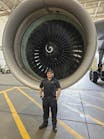KLM and TU Delft Join Forces to Make Aviation More Sustainable
NEW YORK – June 3, 2019 – The aircraft’s v-shaped design will integrate the passenger cabin, the cargo hold and the fuel tanks in the wings. Its improved aerodynamic shape and reduced weight will mean it uses 20% less fuel than the Airbus A350, today’s most advanced aircraft. A flying scale model and a full-size section of the interior of the Flying-V will be officially presented at the KLM Experience Days at Amsterdam Airport Schiphol in October on the occasion of KLM’s 100th anniversary.
The aircraft was originally conceptualized as a potential aircraft design for the future, but can be compared to today’s most advanced aircraft, the Airbus A350. Although the plane is not as long as the A350, it does have the same wingspan. This will enable the Flying-V to use existing infrastructure at airports, such as gates and runways, without difficulty and the aircraft will also fit into the same hangar as the A350. What’s more, the Flying-V will carry the same number of passengers – 314 in the standard configuration – and the same volume of cargo, 160m3. The Flying-V will be smaller than the A350, giving it less aerodynamic resistance.
KLM President & CEO Pieter Elbers: “In recent years, KLM has developed as a pioneer in sustainability within the airline industry. The development of aviation has given the world a great deal, offering us an opportunity to connect people. This privilege is paired with a huge responsibility for our planet. KLM takes this very seriously and has therefore been investing in sustainability at different levels for many years, enabling it to develop a broad spectrum of sustainability initiatives. We are proud of our progressive cooperative relationship with TU Delft, which ties in well with KLM’s strategy and serves as an important milestone for us on the road to scaling-up sustainable aviation.”
Dean of the Faculty of Aerospace Engineering at TU Delft Professor Henri Werij: “We are incredibly pleased to be able to cooperate with our trusted partner KLM on our combined mission to make aviation more sustainable. Radically new and highly energy-efficient aircraft designs such as the Flying-V are important in this respect, as are new forms of propulsion. Our ultimate aim is one of emission free flight. Our cooperation with KLM offers a tremendous opportunity to bring about real change.”
Improved passenger experience The Flying-V also provides researchers a unique opportunity to improve passenger experience in aircraft, from the seating layout in the wings, to the design of the seats and bathrooms. Everything has to be as lightweight as possible in order to maximise the efficiency gain the new aircraft shape provides. Passenger comfort is also taken into account.
Fuel versus electric propulsion The Flying-V is propelled by the most fuel-efficient turbofan engines that currently exist. In its present design it still flies on kerosene, but it can easily be adapted to make use of innovations in the propulsion system – by using electrically-boosted turbofans for example.



